A cycle followed by an engine (made of one mole of an ideal gas in a cylinder with a piston) is shown in figure. Find heat exchanged by the engine, with the surroundings for each section of the cycle. CV=32R

(a) A to B : constant volume
(b) B to C: constant pressure
(c) C to D: adiabatic
(d) D to A: constant pressureSolution in Gujrati
(a)For process A to B volume is constant hence work done dW=0
⇒ From first law of thermodynamics ,
dQ=dU+dW
∴ dQ=dU+0
∴ dQ=dU
=nCVdT
=nCV(TB−TA)
=(1)(32R)(TB−TA)
=32(RTB−RTA)
=32(PBVB−PAVA)
because in equation of gas PV = RT at point A, PAVA=RTA and at point B, PBVB=RTB
∴ Heat enchanged =32(PBVB−PAVA)
(b) For process B to C pressure is constant hence work done,
dW=PΔV
∴dW=PB(VC−VB)
⇒ From first law of thermodynamics,
dQ=dU+dW
=32R(TC−TB)+PB(VC+VB)
∴dQ=32(RTC−RTB)+PB(VC−VB)
=32(PCVC−PBVB)+PB(VC−VB)
=52PB(VC−VB) [ ∵PB=PC and PB=PA ]
∴ Heat exchanged =52PB(VC−VA)
(d) For process C to D , it is adiabatic process so heat exchanged dQ=0
(d) For process D to A at constant pressure PA the gas compressed from volume VD to VA The heat exchanged will be as shown in (b) PA instead of PB, VA instead of VC and VA instead of VD have to be taken.
∴ Heat exchanged dQ=52PA(VA−VD)
Topper's Solved these Questions
- THERMODYANMICS BOOK - KUMAR PRAKASHANCHAPTER - THERMODYANMICS EXERCISE - Section-E MCQs
42 Videos
- THERMODYANMICS BOOK - KUMAR PRAKASHANCHAPTER - THERMODYANMICS EXERCISE - Section-F Questions from Module
20 Videos
- THERMODYANMICS BOOK - KUMAR PRAKASHANCHAPTER - THERMODYANMICS EXERCISE - Section-D Ncert Exemplar Solution (Short Answer )
6 Videos
- THERMAL PROPERTIES OF MATTERBOOK - KUMAR PRAKASHANCHAPTER - THERMAL PROPERTIES OF MATTEREXERCISE - Question Paper (Section - D) (Answer following in brief :) Each carry 4 marks
1 Videos
- UNITS AND MEASUREMENTBOOK - KUMAR PRAKASHANCHAPTER - UNITS AND MEASUREMENTEXERCISE - Section -F (Questions from Module )
20 Videos
Similar Questions
Heat absorbed by the gas undergo a cylic process along closed path in one complete cycle as shown in figure will be _____ J.

View SolutionIn a thermodynamics process which one of the following statement is not true ?
View SolutionConsider a Carnot's cycle operating between T1 = 500 K and T2 = 300 K producing 1 kJ of mechanical work per cycle. Find the heat transferred to the engine by the reservoirs.
View SolutionIn an experiment on the specific heat of a metal, a 0.20 kg block of the metal at 150∘C is dropped in a copper calorimeter (of water equivalent 0.025 kg) containing 150 cm3 of water at 27∘C. The final temperature is 40∘C. Compute the specific heat of the metal. If heat losses to the surroundings are not negligible, is your answer greater or smaller than the actual value for specific heat of the metal ?
View SolutionIf the error in measurement of radius of a shpere is 2% then the error in determination of volume of the sphere will be …………
View SolutionA cycle followed by an engine (made of one mole of perfect gas in a cyclinder with a piston) is shown in (figure) A to B: volume constant B to C: adiabatic C to D: volume constant D to A: adiabatic V_(c)=V_(D)= 2V_(A)= 2V_(B) (a) In which part of the cycle heat is supplied to the engine fron outside? (b) In which part of the cycle heat is being given to the surrounding by the engine? (c ) What is the work done by the engine in one cycle? Write your answer in term of P_(A), P_(B), V_(A) . (d) What is the efficiency of the engine? (gamma= 5//3 "for the gas") , (C_(v)=3/2R "for one mole")
View SolutionA cycle followed by an engine (made of one mole of an ideal gas in a cyclinder with a piston) is shown in (figure). Find heat exchanged by the engine, with the surrounding for each section of the cycle. [C_(V)= (3//2)R] AB : constant volume BC : constant pressure CD : adiabatic DA : constant pressure.
View SolutionA cycle followed by an engine (made of one mole of perfect gas in a cylinder with a piston) is shown in figure.
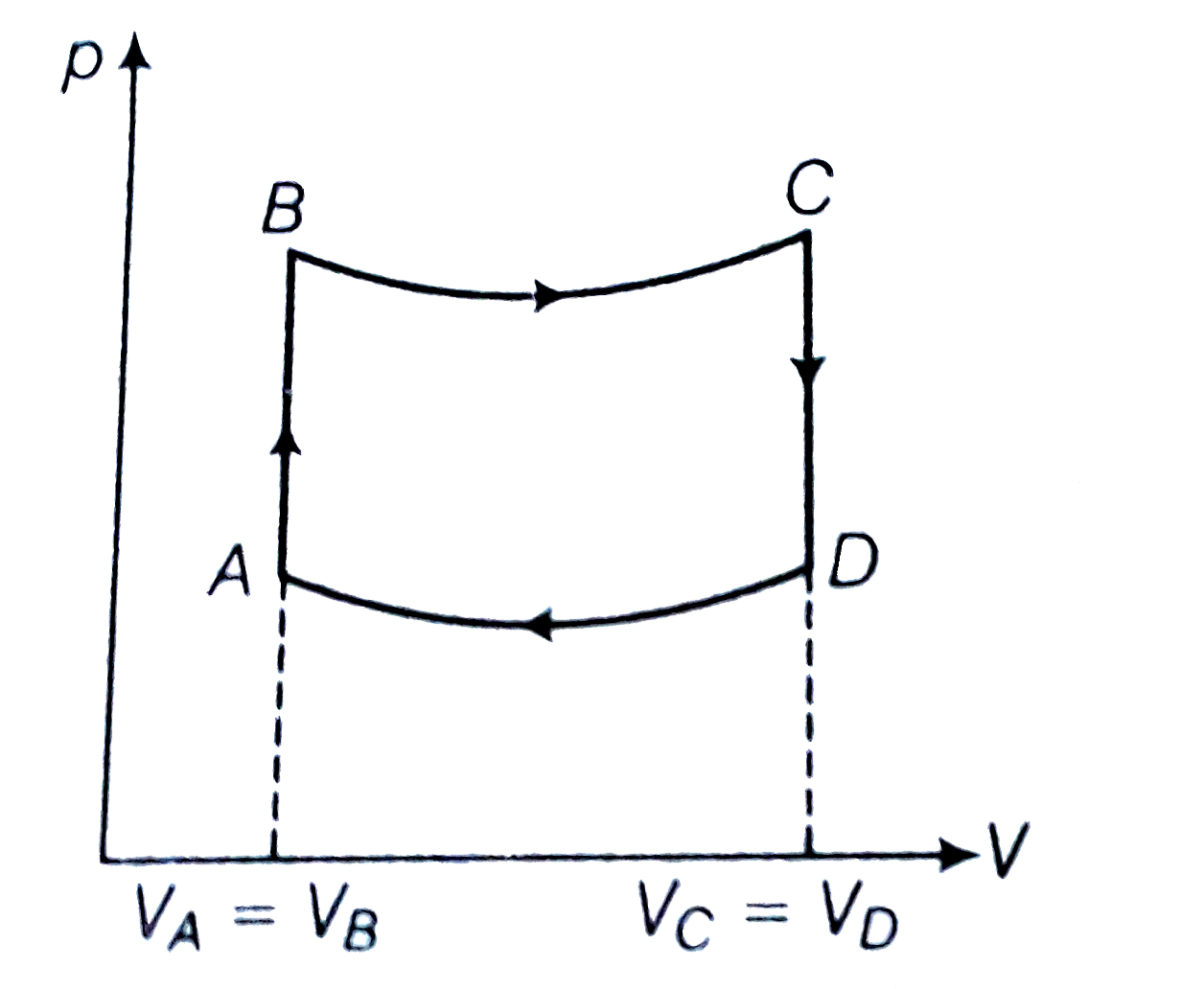
A to B volume constant, B to C adiabatic, C to D volume constant and D to A adiabatic
VC=VD=2VA=2VB
(a) In which part of the cycle heat is supplied to the engine form outside?
(b) In which part of the cycle heat is being given to the surrounding by the engine ?
(c ) What is the work done by the engine in one cycle ? Write your answer in term of pA,pB,VA ?
(d) What is the efficiency of the engine ?
(γ=53 for the gas), (CV=32R for one mole )
View SolutionA cycle followed by an engine (made of one mole of an ideal gas in a cyclinder with a piston ) is shown if figure . Find heat exchanged by the enigen, with the surrodings for each section of the cycle . [C_(V) = (3//2) R]
View SolutionThe cycle in the figure followed by an engine made of an ideal gas in ca cylinder with a piston, the heat exchanged by the engine with the surroundings for adiabatic section AB of cycle is (C_(V)=(3)/(2)R)
View SolutionA cycle followed an engine (made of one mole of an ideal gas in a cylinder with a piston) is shown in figure The heat exchanged by the engine with the surroundings at constant volume is (Take CV=32R)
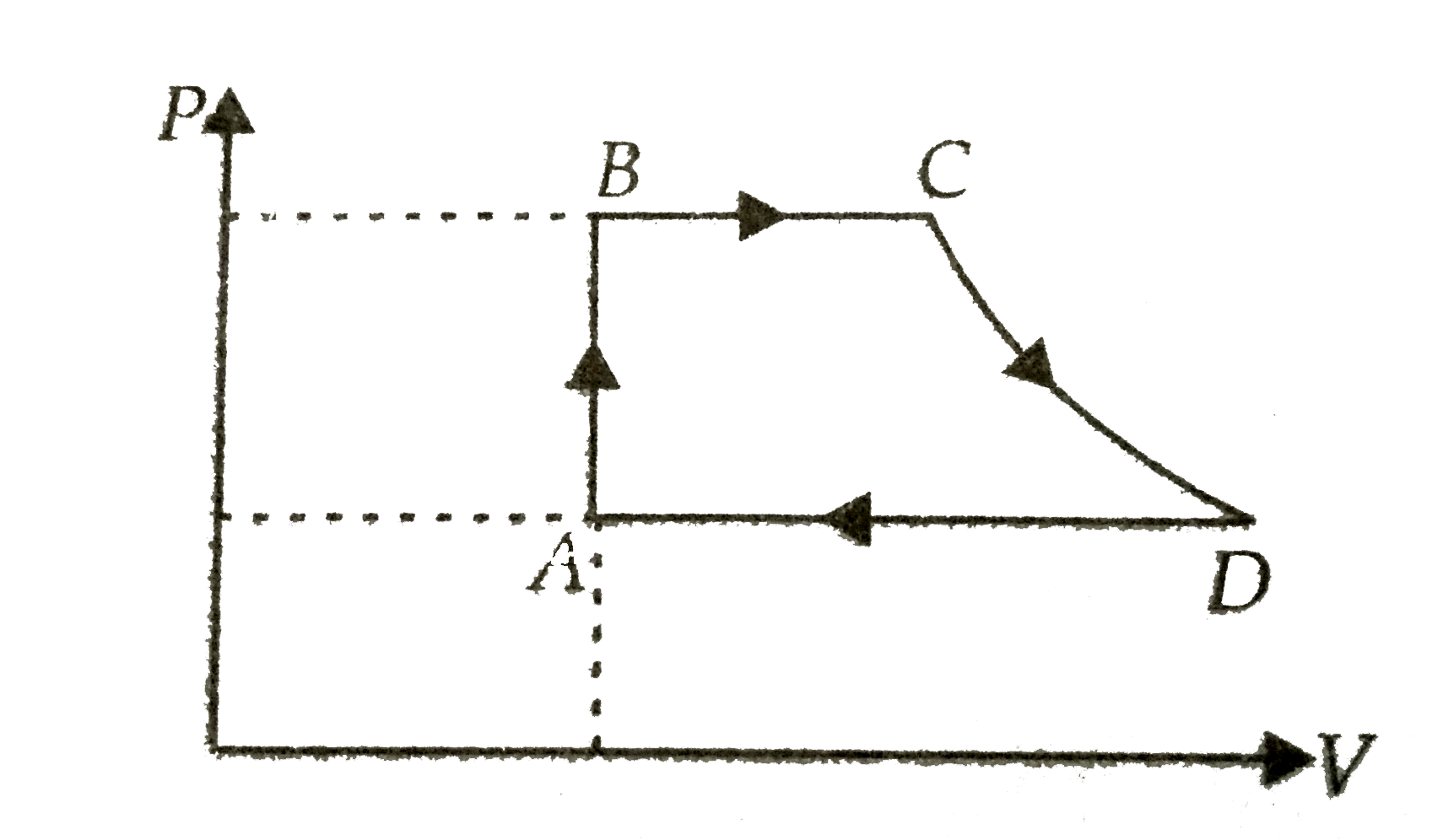
View SolutionThe cycle is shown in figure is made of one mole of perfect gas in a cylinder with a piston . The processes A to B and C to D are isochoric wheras process B to C and D to A are adiabatic, the work done in one cycle is (VA=VB=V,VC=VD=2Vand γ=5/3)
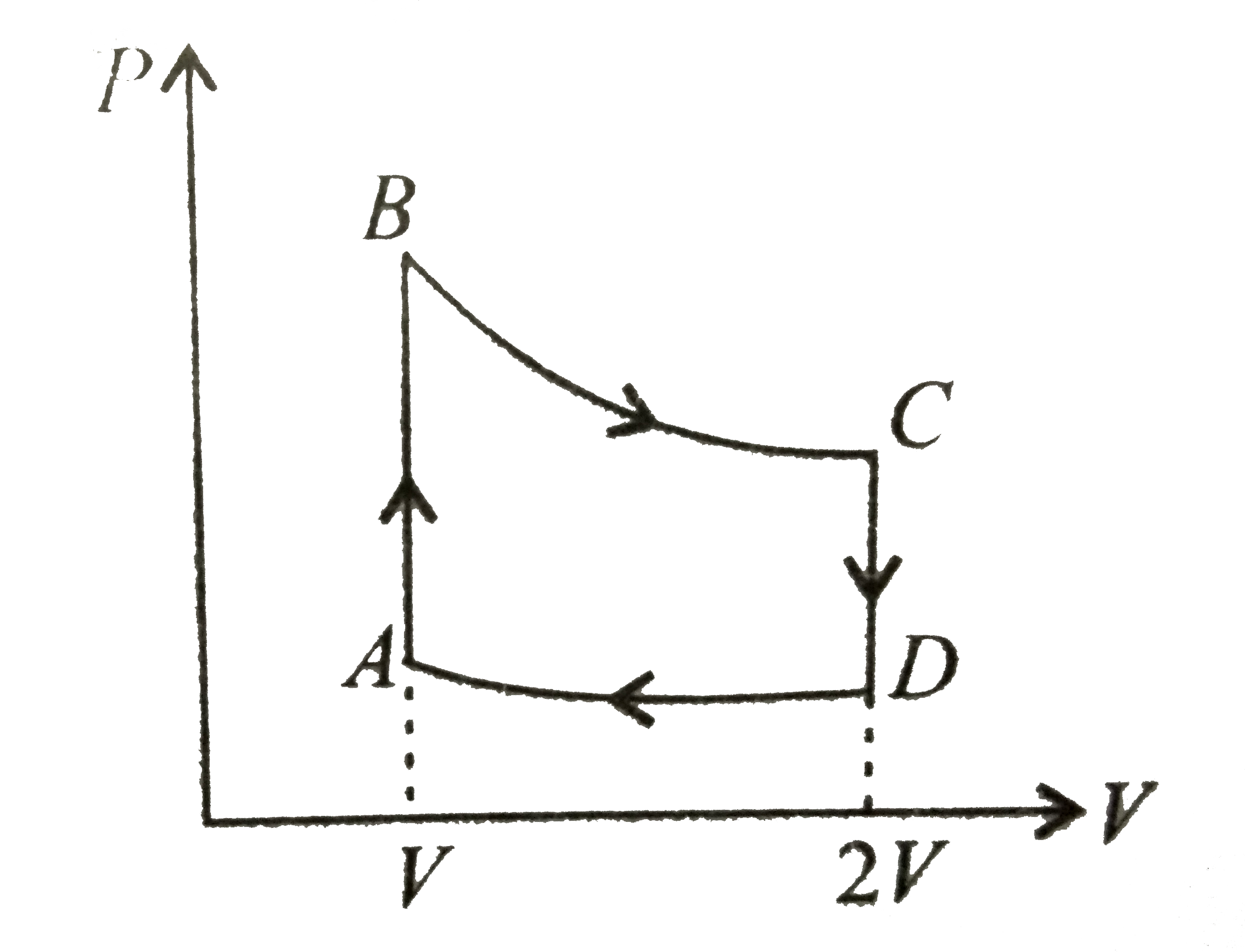
View SolutionA cycle followed by an engine (made of one mole of perfect gas in a cylinder with a piston) is shown in figure.
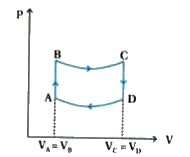
A to B: volume constant
B to C: adiabatic
C to D: volume constant
D to A: adiabatic
VC=VD=2VA=2VB
(a) In which part of the cycle heat is supplied to the engine from outside ?
(b) In which part of the cycle heat is being given to the surrounding by the engine ?
(c) What is the work done by the engine in one cycle ? Write your answer in term of PA,PB,VA
(d) What is the efficiency of the engine ? (γ=53 for the gas , CV=32R for one mole )
View SolutionA cycle followed by an engine (made of one mole of perfect gas in a cylinder with a piston) is shown in figure. A to B volume constant, B to C adiabatic, C to D volume constant and D to A adiabatic " "V_(C)=V_(D)=2V_(A) = 2V_(B) (a) In which part of the cycle heat is supplied to the engine form outside? (b) In which part of the cycle heat is being given to the surrounding by the engine ? (c ) What is the work done by the engine in one cycle ? Write your answer in term of p_(A),p_(B),V_(A) ? (d) What is the efficiency of the engine ? " "(gamma=(5)/(3) for the gas ) , (C_(V)= (3)/(2)R for one mole )
View SolutionA cycle followed by an engine (made of one mole of an ideal gas in a cyclinder with a piston ) is shown if figure . Find heat exchanged by the enigen, with the surrodings for each section of the cycle . [CV=(3/2)R]
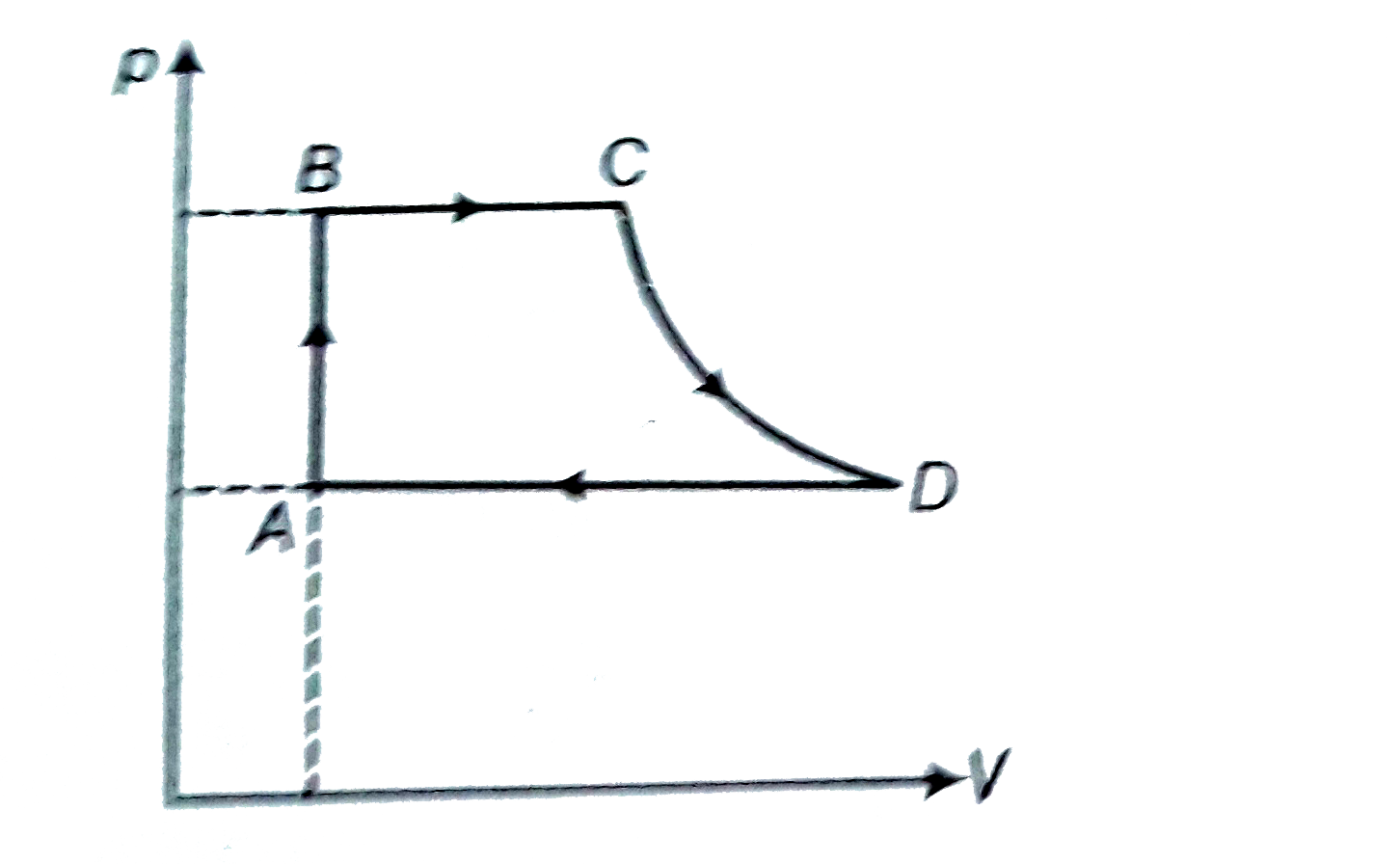
View Solution
